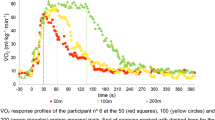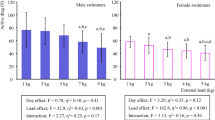Summary
The purpose of this investigation was to test whether the concept of critical power used in previous studies could be applied to the field of competitive swimming as critical swimming velocity (νcrit). The νcrit, defined as the swimming velocity over a very long period of time without exhaustion, was expressed as the slope of a straight line between swimming distance (d lim) at each speed (with six predetermined speeds) and the duration (t lim). Nine trained college swimmers underwent tests in a swimming flume to measure νcrit at those velocities until the onset of fatigue. A regression analysis ofd lim on trim calculated for each swimmer showed linear relationships (r 2>0.998,P<0.01), and the slope coefficient signifying νcrit ranged from 1.062 to 1.262 m · s−1 with a mean of 1.166 (SD 0.052) m · s−1. Maximal oxygen consumption (\(\dot VO_{2\max } \)), oxygen consumption (\(\dot VO_2 \)) at anaerobic threshold, and the swimming also velocity at the onset of blood lactate accumulation (νOBLA) were also determined during the incremental swimming test. The νcrit showed significant positive correlations with\(\dot VO_2 \) at anaerobic threshold (r=0.818,P<0.01), νOBLA (r=0.949,P<0.01) and mean velocity of 400m freestyle (r=0.864,P<0.01). These data suggested that νcrit could be adopted as an index of endurance performance in competitive swimmers.
Similar content being viewed by others
References
Allen WK, Seals DR, Hurley B, Ehsani AA, Hagberg JM (1985) Lactate threshold and distance running performance in young and old endurance athletes. J Appl Physiol 58: 1281–1284
Arabas C, Mayhew L, Hudgins PM, Bond GH (1987) Relationships among work rates, heart rates, and blood lactate levels in female swimmers. J Sports Med 27: 291–295
Åstrand PO, Englesson B (1972) A swimming flume. J Appl Physiol 33: 514
Costill DL, Kovaleski D, Porter D, Kirwan J, Fielding R, King D (1985) Energy expenditure during front crawl swimming: predicting success in middle-distance events. Int J Sports Med 6: 266–270
Davis JA, Vodak P, Wilmore JH, Vodak J, Kurtz P (1976) Anaerobic threshold and maximal aerobic power for three modes of exercise. J Appl Physiol 41: 544–550
de Vries HA, Moritani T, Nagata A, Magnussen K (1982) The relation between critical power and neuromuscular fatigue as estimated from electromyographic data. Ergonomics 25: 783–791
Farrell PA, Wilmore JH, Coyle EF, Billing JE, Costill DL (1979) Plasma lactate accumulation and distance running. Med Sci Sports Exerc 11: 338–344
Heck H, Mader A, Hess G, Mucke S, Muller R, Hollmann W (1985) Justification of the 4-mmol/1 lactate threshold. Int J Sports Med 6: 117–130
Ivy JL, Withers RT, Van Handel PJ, Elger DH, Costill DL (1980) Muscle respiratory capacity and fiber type as determinants of the lactate threshold. J Appl Pbysiol 48: 523–527
Jenkins DG, Quigley BM (1990) Blood lactate in trained cyclists during cycle ergometry at critical power. Eur J Appl Physiol 61: 278–283
Karlsson J, Holmgren A, Linnarson D, Astrom H (1984) OBLA exercise stress testing in health and disease. In: Lollgan L, Mellerowicz H (eds) Progress in ergometry: quality control and test criteria. Springer, Berlin Heidelberg New York, pp 67–91
Kumagai S, Tanaka K, Matsuura Y, Matsuzaka A, Hirakoba K, Asano K (1983) Relationships of anaerobic threshold and the onset of blood lactate accumulation with endurance performance. Eur J Appl Physiol 52: 51–56
Mader A, Madsen O, Hollmann W (1980) Zur Beurteilung der laktaziden Energiebereitstellung für Trainings- und Wettkampfleistungen im Sportschwimmen. Leistungssport 10: 263–268
Madsen O, Lohberg M (1987) The lowdown on lactates. Swimming Techn 24: 21–26
Maglischo EW, Maglischo CW, Bishop RA (1982) Lactate testing for training pace. Swimming Techn 19: 31–37
Monod H, Scherrer J (1965) The work capacity of a synergic muscular group. Ergonomics 8: 329–337
Moritani T, Nagata A, de Vries HA, Muro M (1981) Critical power as a measure of physical work capacity and anaerobic threshold. Ergonomics 24: 339–350
Nagata A, Moritani T, Muro M (1983) Critical power as a measure of muscular fatigue and anaerobic threshold. In: Matsui H, Kobayashi K (eds) Biomechanics VIIIA. Human Kinetics, Champaign, Ill., pp 312–320
Nomura T (1982) The influence of training and age on\(\dot VO_{2\max } \) during swimming in Japanese elite age group and olympic swimmers. In: Hollander AP, Huijing PA, Groot GD (eds) Biomechanics and medicine in swimming 14. Human Kinetics, Champaign, Ill., pp 251–257
Olbrecht J, Madsen O, Mader A, Liesen H, Hollmann W (1985) Relationship between swimming velocity and lactic concentration during continuous and intermittent training exercises. Int J Sports Med 6: 74–77
Ribeiro JP, Cadavid E, Baena J, Monsalvete E, Barna A, De Rose EH (1990) Metabolic predictors of middle-distance swimming performance. Br J Sports Med 24: 196–200
Sawka MN, Knowlton RG, Miles DS, Critz JB (1979) Postcompetition blood lactate concentrations in collegiate swimmers. Eur J Appl Physiol 41: 93–99
Skinner J (1987) The new, metal-plated assistant coach. Swimming Technique 24: 7–12
Tanaka K, Matsuura Y, Matsuzaka A, Hirakoba K, Kumagai S, Sun-O S, Asano K (1984) A longitudinal assessment of anaerobic threshold and distance running performance. Med Sci Sports Exerc 16: 278–282
Tanaka K, Nakazawa T, Hazama T, Matsuura Y, Asano K (1985) A prediction equation for indirect assessment of anaerobic threshold in male distance runners. Eur J Appl Physiol 54: 386–390
Wasserman K, Whipp BJ, Koyal SN, Beaver ML (1973) Anaerobic threshold and respiratory gas exchange during exercise. J Appl Physiol 35: 236–243
Yoshida T (1986) Relationship of lactate threshold and onset of blood lactate accumulation as determinants of endurance ability in untrained females. Ann Physiol Anthropol 5: 205–209
Yoshida T, Chida M, Ichioka M, Suda Y (1987) Blood lactate parameters related to aerobic capacity and endurance performance. Eur J Appl Physiol 56: 7–11
Yoshida T, Udo M, Iwai K, Muraoka I, Tamaki K, Yamaguchi T, Chida M (1989) Physiological determinants of race walking performance on female race walkers. Br J Sports Med 23: 250–254
Yoshida T, Udo M, Iwai K, Chida M, Ichioka M, Nakadomo F, Yamaguchi T (1990) Significance of the contribution of aerobic and anaerobic components to several distance running performances in females athletes. Eur J Appl Physiol 60: 249–253
Author information
Authors and Affiliations
Rights and permissions
About this article
Cite this article
Wakayoshi, K., Ikuta, K., Yoshida, T. et al. Determination and validity of critical velocity as an index of swimming performance in the competitive swimmer. Europ. J. Appl. Physiol. 64, 153–157 (1992). https://doi.org/10.1007/BF00717953
Accepted:
Issue Date:
DOI: https://doi.org/10.1007/BF00717953




